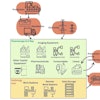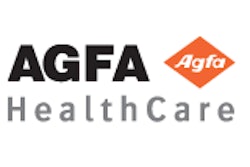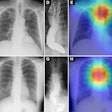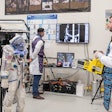CHICAGO - New products in CT, ultrasound, and vascular x-ray are among the highlights in the booth of Toshiba America Medical Systems at this week’s RSNA meeting.
In CT, Asteion Multi 60 is a new multislice scanner that features a 60 kW generator and a 6.5 million-heat-unit (MHU) x-ray tube, compared with the 48 kW generator and 4 MHU tube found on Asteion Multi 48, a less expensive system. The Tustin, CA-based company is also highlighting version 2.0 of its CT console software, which features enhanced flexibility and automation.
Real exposure control (REC) is a Toshiba dose-reduction technique that uses a scout scan to determine the correct mA to use relative to the attenuation characteristics of the patient’s body. The technique modulates the scanner’s tube current during the exam to reduce dose, according to Mark Morrison, product manager of the company’s CT business unit.
In future CT developments, Toshiba plans to have a 16-slice scanner on the market next year. The company also showed an image collected with a 256-row detector currently being developed in Toshiba’s R&D lab. Such a system is still years from commercialization, as it requires major advances in computer horsepower before it can be brought to market, Morrison said.
Infinix is a new angiography platform that comes in a full range of configurations, from single-plane to biplane for applications from cardiac to vascular. Toshiba redesigned many system components to develop the system, including the table, C-arm, and digital imaging chain, according to Raymond Dimas, senior product manager for vascular systems. The unit also supports 3-D vascular studies, which can be reviewed on a 3-D workstation Toshiba developed with partner Vital Images of Minneapolis.
In x-ray, Toshiba has introduced a new rolling tabletop for the Ultimax multipurpose radiography-fluoroscopy system. The table expands the versatility of the product, making it appropriate for nonvascular angiography applications like intestinal studies, said Allan Berthe, Toshiba’s x-ray product manager. The company has also added new pulsed fluoro settings for better radiation dose management, and has expanded the storage capacity of its EPS Plus digital module, which can now hold up to 15,000 studies in online storage.
In ultrasound, Toshiba highlighted two new introductions, Aplio and Nemio. Aplio, a premium system, features multifrequency transducers that support fundamental, harmonic, and multi-Doppler frequencies, according to Toshiba. This allows for improved border detection, axial resolution, and far-field image integrity, according to the vendor.
Nemio is a mid-range scanner that can be configured to perform ob/gyn, abdominal, vascular, cardiac, and small-parts imaging, according to Toshiba. Nemio, which includes an advanced 3-D imaging package, replaces Toshiba's longtime Echocee scanner in the company’s product line. With basic configurations, Aplio and Nemio will sell for approximately $185,000, and $75,000, respectively.
The focus in MRI is on Opart, a 0.35-tesla superconducting open scanner, and Excelart, Toshiba’s entry in the high-field market. Opart has new version 4.0 software, and the company is developing new high-strength gradients with a 100 mT/m/ms slew rate. The new gradient package should be available in about a year, according to Anita Bowler, Opart product manager.
For Excelart, Toshiba is highlighting its Spin Technology package, which incorporates three Toshiba techniques: Pianissimo gradient noise reduction, SPEEDER parallel imaging, and Interactive scan-plane navigation. SPEEDER and Interactive were shown as works-in-progress, and should be available in late 2002, according to high-field product manager Al Najera.
In PACS, Toshiba highlighted its commitment to the Integrating the Healthcare Enterprise initiative with its SimPACS digital image management offering. Toshiba partners with Agfa HealthCare of Ridgefield Park, NJ, for SimPACS. Toshiba’s nuclear medicine highlights focused on the company’s Web-based promotional effort, which lists gamma cameras at up to 15% below industry average prices, according to the company.
By Brian Casey and Erik L. Ridley
AuntMinnie.com staff writers
November 29, 2001
For the rest of our coverage of the 2001 RSNA meeting, go to our RADCast@RSNA 2001.
Copyright © 2001 AuntMinnie.com



















